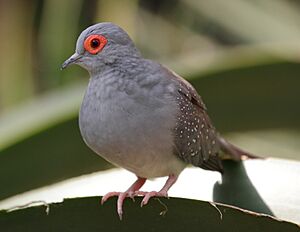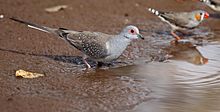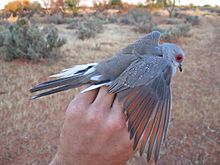Diamond dove facts for kids
Quick facts for kids Diamond dove |
|
|---|---|
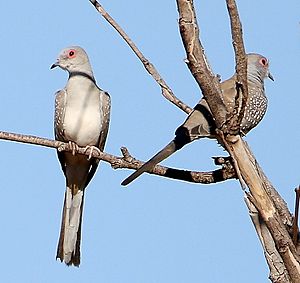 |
|
| Northern Territory, Australia. | |
| Conservation status | |
| Scientific classification | |
| Genus: |
Geopelia
|
| Species: |
cuneata
|
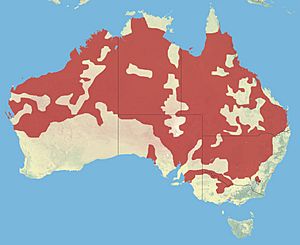 |
|
| distribution | |
The diamond dove (Geopelia cuneata) is a small bird that lives in Australia. These tiny doves mostly live in dry or semi-dry areas of Central, West, and Northern Australia. They usually stay close to water sources.
Diamond doves are one of Australia's smallest pigeons, similar in size to the peaceful dove. Sometimes, when the center of Australia is very dry, they can be seen in parks and gardens in Southern Australia.
Contents
What Do Diamond Doves Look Like?
Diamond doves are small birds, about 19 to 21 centimeters (7.5 to 8.3 inches) long. Both male and female doves have white spots with black edges on their wings. They also have bright red eyes surrounded by orange rings.
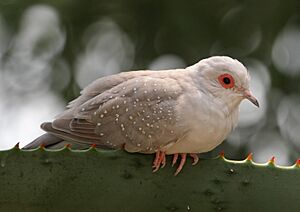
Males and females look quite similar. However, the female's eye ring is usually less bright. Her feathers might also have a bit more brown color. The male's head, neck, and chest are a pretty light blue-grey.
Their beak is dark grey. Their belly is creamy, and their back and tail are brown-grey. Their legs and feet are pink.
Young diamond doves look a bit different. Their beak is light grey, and their eyes and eye rings are a fawn color. Their legs and feet are grey, and their chest is grey. They also do not have the white spots on their wings yet.
How Do Diamond Doves Behave?
Diamond doves are often seen on the ground. They run with a cute waddling walk. When they fly, their flight is strong and direct. Their wings can make a whistling "frrr" sound as they fly.
These doves usually gather in pairs or small groups. They feed on the ground, mostly eating seeds from grasses. They will also eat ants sometimes.
Diamond doves tend to breed after rain, especially in spring in Southern Australia. Their nests are often built from woven grasses or small twigs. These nests are usually quite delicate. The female typically lays two white eggs. Both parents take turns keeping the eggs warm for about 13 to 14 days.
Their chicks grow very quickly. They are usually fully feathered and able to fly by the time they are two weeks old.
Diamond doves have many different calls. Their calls sound a bit sad and soft, with a pleasant, high-pitched quality. One common call is two long coos, then a pause, followed by a long, short, and long coo. Sometimes they just make two long coos. If they are alarmed, they will make a few short but loud coos.
Are Diamond Doves Protected?
In Australia, diamond doves are not listed as a threatened species under the national environmental law. This means they are not currently considered to be in danger of disappearing.
However, in the state of Victoria, Australia, the diamond dove is listed as "near-threatened." This means they are close to being considered threatened, and their numbers are being watched carefully.
Gallery
-
A diamond dove next to a zebra finch at a waterhole in the Northern Territory, Australia.
See also
 In Spanish: Tortolita diamante para niños
In Spanish: Tortolita diamante para niños



